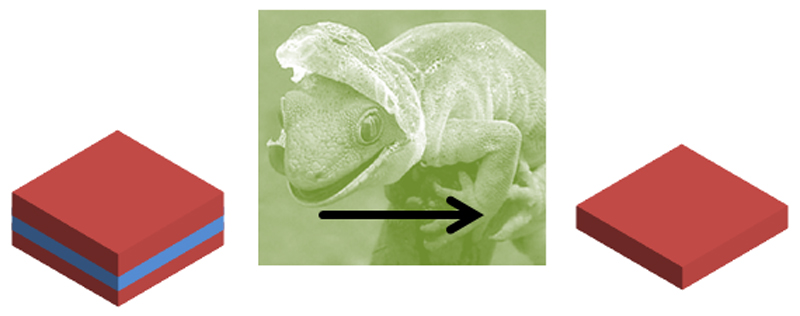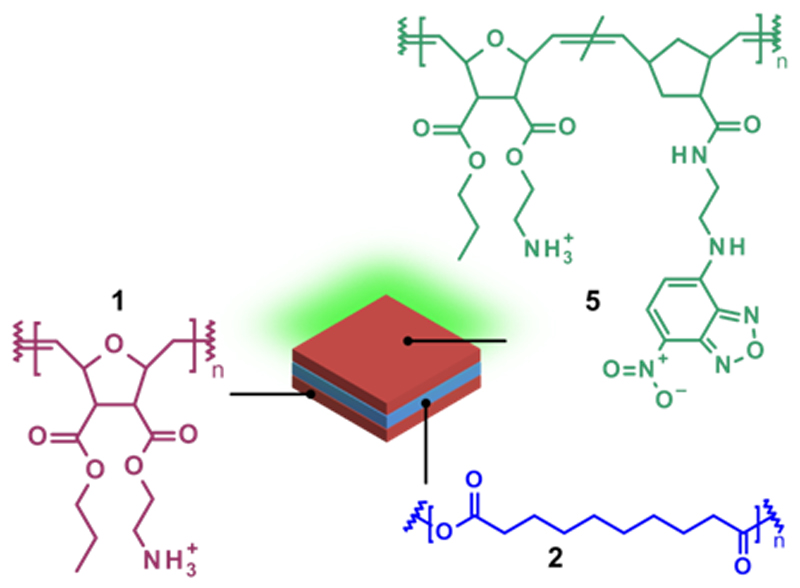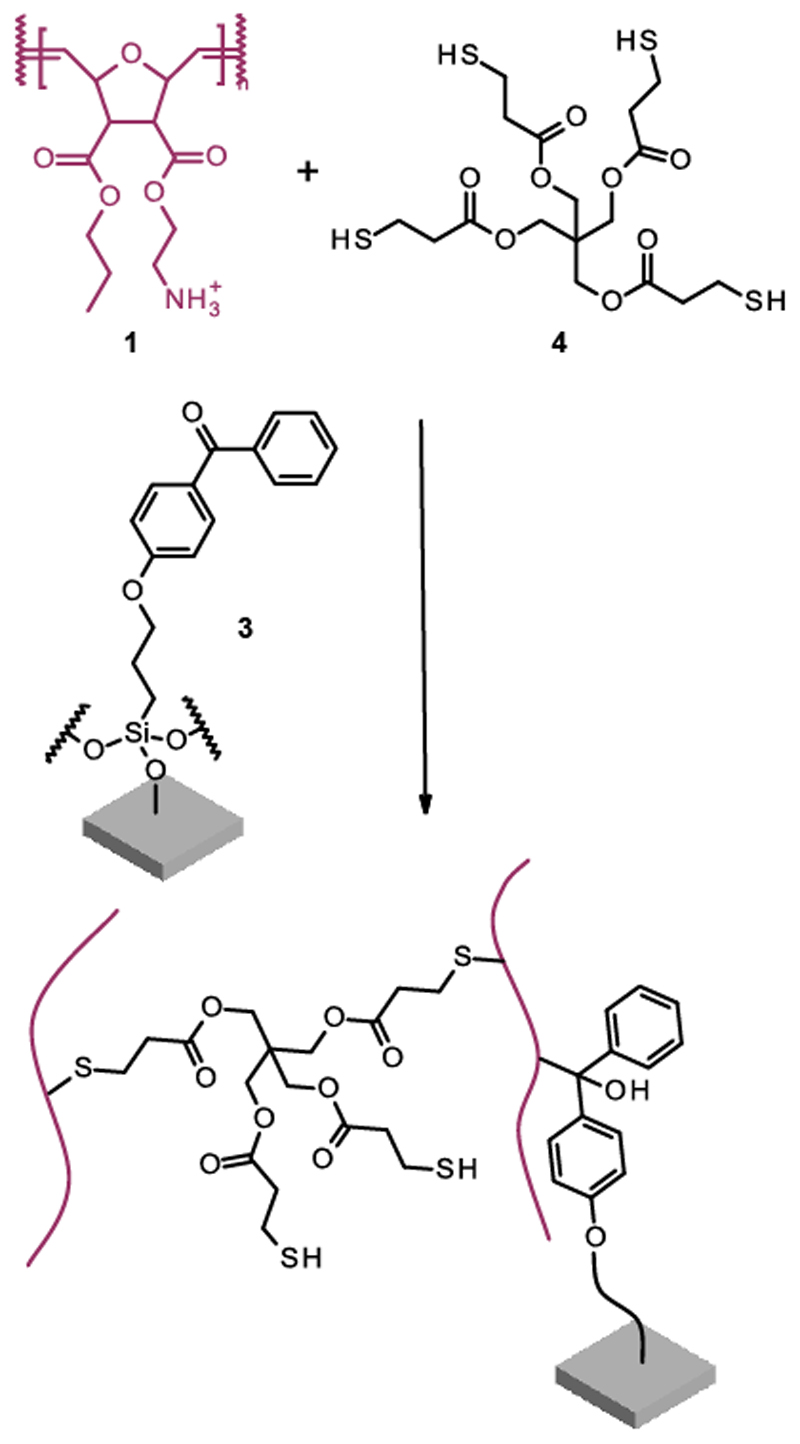Abstract
Regeneration of functional polymer surfaces after damage or contamination is an unresolved scientific challenge, and also of practical importance. In this proof-of-concept study, we present a method to regenerate a functional surface property using a polymer multi-layer architecture. This is exemplified using antimicrobially active surfaces. The idea is to shed the top layer of the polymer layer stack, like a reptile shedding its skin. The proof-of-concept stack consists of two antimicrobial layers and a degradable interlayer. Shedding of the top layer is enabled by degrading that interlayer. The shedding process was analyzed by quantitative fluorescence microscopy, ellipsometry, and FTIR spectroscopy. Antimicrobial assays revealed that the functionality of the emerging antimicrobial layer was fully retained after shedding.
Functional surface coatings often fail because of damage or contamination. In particular, contact-killing antimicrobial coatings become inactive when they get covered by dead bacteria, proteins and other biomolecules. This enables incoming bacteria to settle, proliferate, and form a biofilm. Once encapsulated in the biofilm, bacteria are inaccessible for antibiotics or the immune system. This makes biofilms a severe infection threat, in particular in the context of medical devices.1 Previous efforts to improve antimicrobial coatings mostly focused on activity optimization, surface regeneration through washing, or combination of antimicrobial and antifouling moieties.2 The perfect long term active surface, however, has yet to be found.
We here present how we approached the aim of sustained surface activity from a different perspective. We designed a system that is able to regenerate its surface functionality by removing the worn-out top layer, and uncover a new, active layer - like a reptile shedding its skin. While the idea is simple, the selective shedding of thin films from polymer layer multi-stacks – either in one piece or in fragments - is so far an unresolved scientific problem. For example, work by David Lynn based on layer-by-layer (LbL) systems3 demonstrated that it was not possible to selectively shed layers from LbL assemblies because of the notorious layer inter-penetration of these systems.4 In our system, we enabled layer shedding by sandwiching a degradable interlayer between two functional layers. When the interlayer degrades, the top functional layer loses adhesion to the remaining layers, and is thus removed. This is illustrated in Figure 1. This approach was also inspired by the sacrificial layer technique used in microsystems fabrication.5 It works because it avoids the problem of breaking adhesive forces between two adjacent functional layers. For ssimple erodible or degradable materials, there is no control over surface morphologies and properties once the degradation process starts. In this system, we dial in the surface properties of the emerging layers during build-up of the stack, and can retrieve them by quantitative removal of the upper degradable layer.
Figure 1.
Inspired by nature: just like a reptile sheds its skin, the three-layer polymer sheds its exhausted top layer, and in so doing uncovers a new functional layer. The shedding is enabled by degrading the interlayer (light blue) between the two functional layers (red).
Designing a system that can perform as anticipated was far from trivial. We concluded from the LbL work3 that non-electrostatic layer interaction and, importantly, somewhat thicker layers were needed to achieve the aim of discrete single layer shedding (or shedding of fragments originating from a single layer). Overall, we identified the following requirements for our target system: First, we need a thickness well above the typical polymer thin film roughness (a few nanometers) to obtain discrete layers that do not interpenetrate or undergo mixing. We chose a thickness of about 100 nm to be well above this value. Next, to allow layer shedding, covalent bonds between adjacent layers must be prevented. Consequently, all interlayer forces needed to be based on physisorption, and had to be carefully adjusted. To allow controlled layer shedding, the system had to be stable under aqueous conditions without premature delamination or dissolution. Thus, the solubility of the polymers had to be carefully chosen, and the water-soluble 100 nm ‘thick’ thin films in the stack had to be stabilized internally by intra-layer cross-linking. This intra-layer cross-linking had to be achieved by a selective process that would not induce interlayer crosslinks. Additionally, to avoid delamination during build-up of the multi-stack, orthogonal solvents had to be used for the individual layers. Finally, all layers needed features that enabled distinguishing them by surface analytical techniques.
All these challenges were addressed in a proof-of-concept system consisting of three layers: an antimicrobial surface-attached polymer network as the bottom layer, a degradable interlayer, and a fluorescent antimicrobial polymer network as the top layer (Figure 2).
Figure 2.
System components: The bottom layer of the proof-of-concept stack consists of the antimicrobial polymer 1, the poly(sebacic anhydride) interlayer 2, and the 2-(4-nitro-2,1,3-benzoxadiazol-7-yl) (NBD) labelled antimicrobial polymer 5.
The antimicrobial layers were made from a special antimicrobial polymer - a poly(oxonorbornene) based synthetic mimic of an antimicrobial peptide (SMAMP, 1 in Figure 2). SMAMP polymers are facially amphiphilic like their natural archetype, the antimicrobial peptide. They carry hydrophobic and hydrophilic, charged moieties that self-segregate onto opposite faces of the molecule. This makes them highly active against bacteria and at the same time compatible with mammalian cells.6 The additional advantage of poly-(oxonorbornene) SMAMPs for our application was that they feature a double bond in the backbone, which can be used for the desired selective intra-layer cross-linking. This cross-linking process has been previously reported.2f, 7 As the degradable interlayer, we chose poly(sebacic anhydride) (PSA 2, Figure 2), which is a water-insoluble polymer. It thus has an orthogonal solubility to the SMAMP, and a bulk degradation rate on the order of days under physiological conditions, with non-toxic degradation products.8 It can be distinguished from the SMAMP layer by the unique anhydride absorption band in FTIR-spectroscopy.
The three layer target system was constructed as follows: the substrate was a silicon wafer functionalized with the benzophenone cross-linker 3 (Figure 3).9 We spin-cast a mixture of the SMAMP polymer 1 (in its Boc-protected form) and the tetrathiol cross-linker 4 (Figure 3) onto that wafer. UV irradiation then enabled two simultaneous reactions – first, the surface immobilization of the polymer by a CH-insertion reaction with the benzophenone moiety 3, and secondly, intra-layer cross-linking through a thiol-ene reaction between the polymer double bonds and the SH groups of cross-linker 4 (Figure 3).7, 10
Figure 3.
Formation of the bottom layer: the antimicrobial polymer 1 was mixed with cross-linker 4, and spin-cast onto a benzophenone-functionalized silicon wafer substrate 3. UV irradiation yielded the surface-attached polymer network.
This yielded the desired surface-attached network as the bottom layer of our polymer stack. The SMAMP bottom layer was deprotected with HCl to remove the Boc protective group. The second layer was applied by spin-casting a solution of PSA onto the surface-attached SMAMP network. Since PSA is insoluble in water, no intra-layer cross-linking was needed to stabilize this layer. The top layer of the stack was obtained by spin-casting of a solution of the novel NBD-dye-labeled poly(oxonorbornene) SMAMP (in its deprotected form, 5 in Figure 2) and cross-linker 4 onto the PSA layer, followed by UV irradiation. This yielded an internally cross-linked network with no covalent bonds to the PSA layer. Due to the fluorescent NBD group, this polymer could be analytically distinguished from the bottom SMAMP layer. All polymer synthesis steps and the layer assembly are described in detail in the Supporting Information.
We could show by immersion into water that the three-layer system was stable, i.e. no shedding and no layer thickness loss was observed. Under physiological conditions (HEPES buffer with 100 mM NaCl), degradation of the interlayer was observed; however quantitative degradation was extremely slow even in the thin film (> 60 hours). To study degradation of this model system in a more reasonable time-frame, the three-layer system was therefore immersed into aqueous HCl. Since we had dye-labeled the top layer of our system, we were able to follow top layer shedding in situ using quantitative fluorescence microscopy. The fluorescence data revealed an exponential decay of fluorescence intensity within 40 min (see Supporting Information). The first layer of the stack, the whole three-layer system before degradation, and the degraded system after HCl treatment were compared using ellipsometry, fluorescence microscopy, and FTIR measurements (Figure 4). Fluorescence microscopy indicated a near-quantitative loss of the top layer: the fluorescence intensity of the degraded system was very close to the intensity of a single SMAMP layer, and significantly lower than that of the strongly fluorescent three-layer system (Figure 4, center column). Ellipsometry measurements confirmed this result (Figure 4, left column). The different thickness loss rates of the system in water, HEPES and HCl indicated that the top layer is shedding through degradation of the interlayer, and not through leaching out of the interlayer as a result of delamination.
Figure 4.
The bottom layer (top row), the three layer system (middle row) and the degraded system (bottom row) were studied using ellipsometry (layer thickness data, left column), quantitative fluorescence microscopy (image recording time and recorded fluorescence intensity (a.u.), middle column) and FTIR spectroscopy (absorption bands of the carbonyl region, right column).
We further investigated the three samples using FTIR spectroscopy (Figure 4, right column). For the three-layer system, we found the expected two signals in the carbonyl stretching vibration region: the one at 1810 cm-1 corresponded to the asymmetric stretching vibration of the PSA anhydride; the one with the maximum at 1740 cm-1 and a shoulder at 1705 cm-1 was an overlay of the symmetric PSA anhydride stretching vibration and the carbonyl stretching vibration of the SMAMP esters. After degradation, only one peak at 1730 cm-1 remained, which matched the FTIR data obtained from a SMAMP single layer. These results indicate that the top two layers of the system had been successfully removed.
To prove the antimicrobial activity of the emergent SMAMP layer, we conducted a standardized antimicrobial activity assay using standardized methods.10–11We sprayed the degraded system and the non-degraded three-layer system with E. coli bacteria (106 bacteria/mL) and quantified the surviving bacteria. The results indicate that the degraded system was as active as the pristine top layer of the three-layer system, with 0 ± 0 surviving colony forming units (CFUs) each, whereas the negative control on a blank silicon wafer had 1059 ± 115 CFUs. The positive control with chlorhexidine digluconate (CHX) also had 0 ± 0 CFUs. We thus could show that the remaining layer of the degraded system fully retained its original antimicrobial activity after layer shedding. This is only possible if a complete or near-quantitative shedding of the interlayer has occurred, as surface irregularities would adversely affect antimicrobial activity.
In conclusion, we illustrated in this proof-of-concept study that it is feasible to shed the top layer from a thin film multi-stack, and showed that we can fully regenerate the intended functional property of the material by this process. This is not only scientifically interesting, but may be useful for applications where retained or regenerated surface properties are needed, e.g. lasting antimicrobial properties for urinary catheters, whose surfaces often fail due to biofilm formation.
We are aware of the fact that there are still open questions, for example: Does the top layer shed as a whole, or is it torn into pieces by mechanical forces when the interlayer underneath degrades? Can the process work in the presence of bacteria under physiological conditions? Even though bacteria in a biofilm can induce low pH similar to our HCl conditions, complete degradation under physiological conditions is of course more relevant for practical applications. We therefore may have to move to a faster degrading poly(anhydride) as the interlayer for biomedical applications. Additionally, the question remains whether we can generalize the shedding principle to selective and sequential layer shedding from a multi-stack with more layers, and to different functionalities. While we are addressing these and other issues in ongoing work, we hope that this communication will inspire research in related fields.
Supporting Information
The entire experimental section, including synthesis and characterization of the novel dye-labeled polymer, assembly and characterization of the multi-stack, degradation studies, and details of the antimicrobial assay can be found in the supporting information. This material is available free of charge via the Internet at http://pubs.acs.org.
Acknowledgment
Thanks to B. Spitzmüller for excellent technical assistance. Funding by the Emmy-Noether program of the Deutsche Forschungsgemeinschaft (German research foundation, DFG; LI1714/5-1), the European Research Council (ERC, Starting Grant, 637920 – Regenerate) and the Klaus-Murmann-Stiftung (sdw) is gratefully acknowledged.
Notes
A. Al-Ahmad and K. Lienkamp are co-inventors of a patent related to this publication. Otherwise, the authors declare no competing financial interest.
References
- 1.Stewart PS, William Costerton J. Antibiotic resistance of bacteria in biofilms. The Lancet. 2001;358(9276):135–138. doi: 10.1016/s0140-6736(01)05321-1. [DOI] [PubMed] [Google Scholar]
- 2.(a) Tiller JC, Liao C-J, Lewis K, Klibanov AM. Designing surfaces that kill bacteria on contact. Proc Natl Acad Sci U S A. 2001;98:5981–5985. doi: 10.1073/pnas.111143098. [DOI] [PMC free article] [PubMed] [Google Scholar]; (b) Tiller JC, Lee SB, Lewis K, Klibanov AM. Polymer surfaces derivatized with poly(vinyl-N-hexylpyridinium) kill airborne and waterborne bacteria. Biotechnol Bioeng. 2002;79:465–471. doi: 10.1002/bit.10299. [DOI] [PubMed] [Google Scholar]; (c) Waschinski CJ, Herdes V, Schueler F, Tiller JC. Influence of satellite groups on telechelic antimicrobial functions of polyoxazolines. Macromol Biosci. 2005;5:149–156. doi: 10.1002/mabi.200400169. [DOI] [PubMed] [Google Scholar]; (d) Waschinski CJ, Barnert S, Theobald A, Schubert R, Kleinschmidt F, Hoffmann A, Saalwaechter K, Tiller JC. Insights in the Antibacterial Action of Poly(methyloxazoline)s with a Biocidal End Group and Varying Satellite Groups. Biomacromolecules. 2008;9:1764–1771. doi: 10.1021/bm7013944. [DOI] [PubMed] [Google Scholar]; (e) Lin J, Tiller JC, Lee SB, Lewis K, Klibanov AM. Insights into bactericidal action of surface-attached poly(vinyl-N-hexylpyridinium) chains. Biotechnol Lett. 2002;24:801–805. [Google Scholar]; (f) Zou P, Hartleb W, Lienkamp K. It takes walls and knights to defend a castle - synthesis of surface coatings from antimicrobial and antibiofouling polymers. J Mater Chem. 2012;22(37):19579–19589. [Google Scholar]
- 3.Lynn DM. Peeling back the layers: Controlled erosion and triggered disassembly of multilayered polyelectrolyte thin films. Advanced Materials. 2007;19(23):4118–4130. [Google Scholar]
- 4.Hammond PT. Engineering materials layer-by-layer: Challenges and opportunities in multilayer assembly. AIChE J. 2011;57:2928–2940. [Google Scholar]
- 5.Ziaie B, Baldi A, Lei M, Gu Y, Siegel RA. Hard and soft micromachining for BioMEMS: review of techniques and examples of applications in microfluidics and drug delivery. Advanced Drug Delivery Reviews. 2004;56(2):145–172. doi: 10.1016/j.addr.2003.09.001. [DOI] [PubMed] [Google Scholar]
- 6.(a) Lienkamp K, Madkour AE, Musante A, Nelson CF, Nusslein K, Tew GN. Antimicrobial Polymers Prepared by ROMP with Unprecedented Selectivity: A Molecular Construction Kit Approach. J Am Chem Soc. 2008;130(30):9836–9843. doi: 10.1021/ja801662y. [DOI] [PMC free article] [PubMed] [Google Scholar]; (b) Al-Ahmad A, Laird D, Zou P, Tomakidi P, Steinberg T, Lienkamp K. Nature-Inspired Antimicrobial Polymers – Assessment of Their Potential for Biomedical Applications. PLoS One. 2013;8(9):e73812. doi: 10.1371/journal.pone.0073812. [DOI] [PMC free article] [PubMed] [Google Scholar]
- 7.Zou P, Laird D, Riga EK, Deng Z, Perez-Hernandez H-R, Guevara-Solarte DL, Steinberg T, Al-Ahmad A, Lienkamp K. Antimicrobial and Cell-Compatible Surface-attached Polymer Networks – How the Correlation of Chemical Structure to Physical And Biological Data Leads to a Modified Mechanism of Action. Journal of Materials Chemistry B. 2015;3:6224–6238. doi: 10.1039/c5tb00906e. [DOI] [PubMed] [Google Scholar]
- 8.Ulery BD, Nair LS, Laurencin CT. Biomedical applications of biodegradable polymers. Journal of Polymer Science Part B: Polymer Physics. 2011;49(12):832–864. doi: 10.1002/polb.22259. [DOI] [PMC free article] [PubMed] [Google Scholar]
- 9.(a) Prucker O, Naumann CA, Ruehe J, Knoll W, Frank CW. Photochemical Attachment of Polymer Films to Solid Surfaces via Monolayers of Benzophenone Derivatives. J Am Chem Soc. 1999;121:8766–8770. [Google Scholar]; (b) Gianneli M, Roskamp RF, Jonas U, Loppinet B, Fytas G, Knoll W. Dynamics of swollen gel layers anchored to solid surfaces. Soft Matter. 2008;4:1443–1447. doi: 10.1039/b801468j. [DOI] [PubMed] [Google Scholar]
- 10.Al-Ahmad A, Zou P, Guevara-Solarte DL, Hellwig E, Steinberg T, Lienkamp K. Development of a standardized and safe airborne antibacterial assay, and its evaluation on antibacterial biomimetic model surfaces. PLoS One. 2014:e111357. doi: 10.1371/journal.pone.0111357. [DOI] [PMC free article] [PubMed] [Google Scholar]
- 11.(a) Haldar J, Weight AK, Klibanov AM. Preparation, application and testing of permanent antibacterial and antiviral coatings. Nature Protocols. 2007;2(10):2412–2417. doi: 10.1038/nprot.2007.353. [DOI] [PubMed] [Google Scholar]; (b) Madkour AE, Dabkowski JM, Nusslein K, Tew GN. Fast Disinfecting Antimicrobial Surfaces. Langmuir. 2009;25(2):1060–1067. doi: 10.1021/la802953v. [DOI] [PMC free article] [PubMed] [Google Scholar]; (c) Standard JI. Antibacterial Products Test for Antibacterial Activity and Efficacy. 2000;Z 2801 [Google Scholar]
Associated Data
This section collects any data citations, data availability statements, or supplementary materials included in this article.






